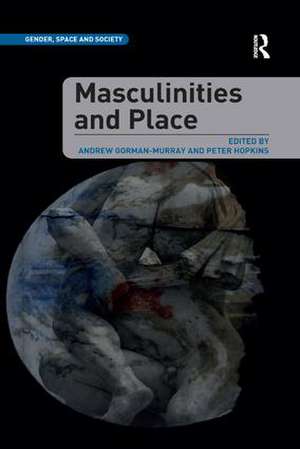Masculinities and Place: Gender, Space and Society
Autor Andrew Gorman-Murray, Peter Hopkinsen Limba Engleză Paperback – 5 feb 2018
| Toate formatele și edițiile | Preț | Express |
|---|---|---|
| Paperback (1) | 338.33 lei 6-8 săpt. | |
| Taylor & Francis – 5 feb 2018 | 338.33 lei 6-8 săpt. | |
| Hardback (1) | 830.43 lei 6-8 săpt. | |
| Taylor & Francis – 10 dec 2014 | 830.43 lei 6-8 săpt. |
Preț: 338.33 lei
Preț vechi: 394.32 lei
-14% Nou
Puncte Express: 507
Preț estimativ în valută:
64.74€ • 70.54$ • 54.55£
64.74€ • 70.54$ • 54.55£
Carte tipărită la comandă
Livrare economică 23 aprilie-07 mai
Preluare comenzi: 021 569.72.76
Specificații
ISBN-13: 9781138547230
ISBN-10: 1138547239
Pagini: 488
Dimensiuni: 156 x 234 x 35 mm
Greutate: 0.45 kg
Ediția:1
Editura: Taylor & Francis
Colecția Routledge
Seria Gender, Space and Society
Locul publicării:Oxford, United Kingdom
ISBN-10: 1138547239
Pagini: 488
Dimensiuni: 156 x 234 x 35 mm
Greutate: 0.45 kg
Ediția:1
Editura: Taylor & Francis
Colecția Routledge
Seria Gender, Space and Society
Locul publicării:Oxford, United Kingdom
Notă biografică
Andrew Gorman-Murray is a lecturer in Social Sciences at the University of Western Sydney, Australia and Peter Hopkins is Professor in Social Geography at Newcastle University, United Kingdom.
Recenzii
’In this wide-ranging tome, the editors have amassed empirical and theoretical work from well-known and emerging scholars around the world ... the editors comprehensively trace the evolutionary trajectory of this topical area ... the editors are to be commended for this timely potpourri of scholarship and contribution to the ever-growing field of men and masculinity studies. Summing up: Highly recommended. Graduate students/faculty.’ Choice ’Offering new insights into the relational connections between masculinities and place, this impressive collection of essays shows how spatial thinking has the potential to destabilise the power hierarchies that inhere within contemporary gender relations. Exploring the intersection of gender and generation, ethnicity and religion, sexuality and space, Masculinities and Place charts an exciting agenda for transformative social change.’ Peter Jackson, University of Sheffield, UK ’This book is evidence of how far the field of masculinities has advanced in recent years. The editors draw together a fantastic array of research from emerging and established scholars. Chapters, many informed by feminism, address topics such as migration, home, family, health and work. This is a must read for anyone interested in gender inequity, social power, identity and space.’ Robyn Longhurst, University of Waikato, New Zealand 'Masculinities and Place overall offers a substantial and far-reaching contribution to both masculinity and place studies. In places, the breadth of the volume leads to a compromise in depth, with some chapters leaving more questions than they answer. The benefit is a single volume which covers a massive range of geography, theory, methodology and approach, sets out definitively the crucial relationship between place and masculinities, and should act as a call for further research and exploration across this intersection.' LSE Review of Books 'This is a good thing for those readers who are looking for a book th
Cuprins
List of Figures and Tables, Notes on Contributors, Acknowledgements, 1. Introduction: Masculinities and Place, Part 1. Introducing and Theorising Masculinities and Place, 2. Theorising, Men, Masculinities, Place and Space: Local, National and Transnational Contexts and Interrelations, 3. Spatio-temporal and Spatio-sensual Assemblages of Youthful Masculinities, 4. Neoliberalism, Masculinities and Academic Knowledge Production: Towards a Theory of ‘Academic Masculinities’, PART 2. Masculinities, Intersectionality and Relationality, 5. ‘I am lord, … I am local’: Migrant Masculinity, Sex and Making Yourself at Home, 6. Negotiating Masculinised Migrant Rights and Everyday Citizenship in a Global City: Brazilian Men in London, 7. ‘Where you are is what you wear’: The Leather Community, International Mr Leather and Hyper-masculinity, 8. Cowboy Masculinities: Relationality and Rural Identity, Part 3. Masculinities and Home, 9. The Geographies of Military Inculcation and Domesticity: Reconceptualising Masculinities in the Home, 10. Violence and Men in Urban South Africa: The Significance of ‘Home’, 11. ‘My place of residence’: Home and Homelessness in the Greater Toronto Area, Part 4. Masculinities and Domestic Labour, 12. Reconceptualising ‘Masculinity’ Through Men’s Contributions to Domestic Foodwork, 13. Materiality, Masculinity and the Home: Men and Interior Design, 14. Working on Masculinity at Home, PART 5. Masculinities and the Family, 15. Domestic Ageing Masculinities and Grandfathering, 16. Intergenerational Relations and Irish Masculinities: Reflections from the Tyneside Irish, in the North-East of England, 17. Emotional Mappings and the Ethnopoetics of Fathering, Part 6. Masculinities, Place and Care, 18. Masculinities, Embodiment and Care, 19. The Gay Bar as a Place of Men’s Caring, 20. ‘It’s a place where all friends meet’: Shared Places, Youth Friendships and the Negotiation of Masculine Identities in Rural Estonia, Part 7. Masculinities, Health and Wellbeing, 21. ‘Being a Man’ in Treatment: Health, Masculinity and the Drama of Independence, 22. Masculinities, Life Courses and Sexual Health: Unpacking HIV Risk and Prevention among Gay Men in Halifax, Nova Scotia, Canada, 23. Masculinities and Mental Health: Geographies of Hope ‘Down Under’, Part 8. Masculinities and Work, 24. Representations, Respect and Resentment: Labour Market Change and Discourses of Masculine Disadvantage, 25. Masculinity in the Marketplace: Geographies of Post-Colonial Gender Work in Modern Fiji, 26. Crafting Masculinities: A Cultural Economy of Surfboard-Making, 27. Performing Rural Masculinities: A Case Study of Diggers and Dealers, Index
Descriere
Masculinities and Place brings together an impressive range of high-profile and emerging researchers to consolidate and expand new domains of interest in the geographies of men and masculinities. It is structured around key and emerging themes within recently completed and on-going research about the intersections between men, masculinities and place. Building upon broader themes in social and cultural geographies, cultural economy and urban/rural studies, the collection is organised around the key themes of: theorising masculinities and place; intersectionality; home; family; domestic labour; work; and health and well-being.




